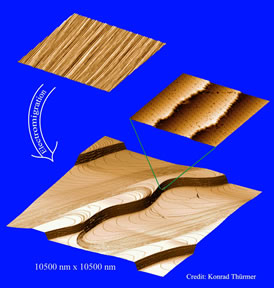





Pattern Formation under Electromigration
| Weak forces acting for long times can create patterns of intriguing beauty, such as those found on sand dunes or in the meandering of river beds. Such familiar geological images are repeated on much smaller length scales on solid surfaces as shown in this figure. Here, the driving is force is very small - it is the force caused by electrons colliding with atoms, otherwise known as the electromigration wind force. Such a small force has big consequences for the electronics industry - electromigration causes changes in the structure of the metal lines that move the electrons around in integrated circuits. This is the single biggest cause of IC failure, and may have unexpected consequences for the performance of nanoelectronic devices. |  |
Direct imaging at length scales as small as those of individual atoms, now let us observe the propagation of mass flow under the electromigration force as revealed by the motion of step edges. The patterned morphology of the silicon surface in the figure is one example of such an investigation. We have demonstrated that such pattern formation can be described quantitatively using linear kinetics acting on the step chemical potentials under the weak wind force. We are linking our developing understanding of the apparently abstract problem of pattern formation to understanding how electromigration forces are going to impact the developing field of nanotechnology. see K. Thürmer, et al. Physical Review Letters 83, 5531 (1999). |
|